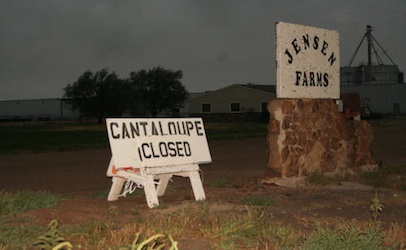
— OPINION —
As of Nov. 17, this year 43 people infected with the outbreak strain of Salmonella have been reported from 15 states. Illnesses started on dates ranging from Oct. 17, 2023, to Nov. 6, 2023. Of 30 people with information available, 17 have been hospitalized. No deaths have been reported.
Canada is also investigating a Salmonella outbreak linked to cantaloupes. The strain causing the outbreak in Canada is the same as the U.S. outbreak strain. The Canadian Food Inspection Agency found Salmonella in a sample of Malichita brand cantaloupe, and whole genome sequencing (WGS) showed that the Salmonella on the cantaloupe is closely related genetically to the bacteria from sick people in Canada. This suggests that people in the Canadian and US outbreaks likely got sick from eating cantaloupe.
It is hard to forget the multistate outbreak of Listeria monocytogenes infections involving 5 distinct strains associated with consumption of cantaloupe grown at Jensen Farms’ production fields in Granada, CO. A total of 147 people were reported to the Centers for Disease Control and Prevention. Thirty-three people died, and one pregnant woman miscarried. Among persons for whom information is available, reported illness onset ranged from July 31, 2011, through Oct. 27, 2011. Ages of ill persons ranged from less than 1 year of age to 96 years, with the median age of 78 years old. Most ill persons were over 60 years old or had health conditions that weakened their immune systems. Seven of the illnesses were related to pregnancy (three newborns; four pregnant women). Among the 145 ill persons with available information on whether they were hospitalized, 143 (99%) were hospitalized. Among the 144 ill persons with available information on what they ate, 134 (93%) reported consuming cantaloupes in the month before illness onset.
Several ill persons remembered the type of cantaloupe they had eaten and said they were Rocky Ford cantaloupes, which are grown in the Rocky Ford region of southeastern Colorado. Source tracing of the cantaloupes indicated that they came from Jensen Farms, and were marketed as being from the Rocky Ford region. These cantaloupes were shipped between July 29 through Sept. 10, 2011, to at least 24 states with possible further distribution. Laboratory testing by the Colorado Department of Public Health and Environment identified Listeria monocytogenes bacteria on cantaloupes collected from grocery stores and from ill persons’ homes. Laboratory testing by FDA identified Listeria monocytogenes matching outbreak strains in samples from equipment and cantaloupe at the Jensen Farms’ packing facility in Granada, CO. The processing equipment and the decision not to chlorinate the water used to wash the cantaloupes were two probable causes of the contamination. Here are some of the 33 who died that I represented:


This outbreak had several unusual features. This was the first listeriosis outbreak associated with melon. Five widely differing pulse field gel electrophoresis (PFGE) pattern combinations and two serotypes (1/2a and 1/2b) were associated with the outbreak. This outbreak was unusually large and resulted in the highest number of deaths of any U.S. foodborne outbreak since a listeriosis outbreak in 1998 (See Bil Mar Foods Ready-to-eat Meats 1998).
(To sign up for a free subscription to Food Safety News,click here)
Note: This article have been indexed to our site. We do not claim legitimacy, ownership or copyright of any of the content above. To see the article at original source Click Here










.jpeg)


